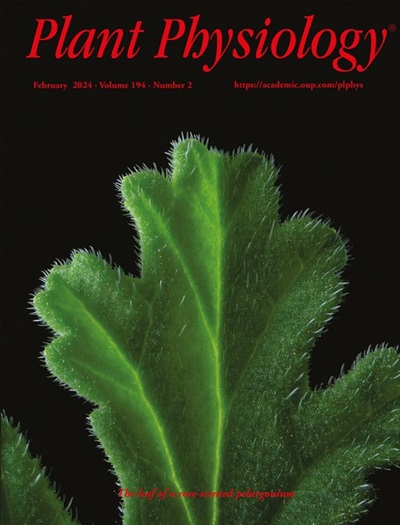dn-OPDA 与氨基酸共轭可抑制其在马钱子中的植物激素生物活性
IF 6.5
1区 生物学
Q1 PLANT SCIENCES
引用次数: 0
摘要
茉莉酸盐是重要的植物激素,可调节植物对生物和非生物胁迫的耐受性以及发育过程。在不同的植物品系中,不同的茉莉酸盐会激活介导这些反应的保守信号通路:裸子植物和狼尾草中的二醛酸-12-氧代-2-磷酸(dn-OPDA)异构体,以及大多数维管束植物中的 JA-Ile。在许多情况下,这些植物激素引发的最终反应取决于特殊代谢物的积累。为了确定肝草(Marchantia polymorpha)中受 dn-OPDA 通路调节的化合物,研究人员针对伤口(一种能激活 dn-OPDA 通路的胁迫)进行了非靶向代谢组分析。这些分析发现了一组以前未报道过的分子:dn-OPDA-氨基酸共轭物(dn-OPDA-aas)。通过对 Marchantia 和我们之前检测到 dn-iso-OPDA 的所有物种进行定向代谢分析,证实了它们在受伤和食草后的积累。GRETCHEN-HAGEN 3A(MpGH3A)的突变体不能积累 dn-OPDA-aa 共轭物,并表现出 OPDA 通路的组成性激活和对食草动物的更强抵抗力。我们的研究结果表明,氨基酸共轭会降低 dn-iso-OPDA 的生物活性。因此,茉莉酸盐在陆生植物中的共轭作用具有两重性:茉莉酸(JA)与异亮氨酸(Ile)共轭可在气管植物中产生具有生物活性的 JA-Ile,而 dn-iso-OPDA 与不同氨基酸共轭则会使毛叶植物和狼尾草植物中的植物激素失活。本文章由计算机程序翻译,如有差异,请以英文原文为准。
dn-OPDA conjugation with amino acids inhibits its phytohormone bioactivity in Marchantia polymorpha
Jasmonates are important phytohormones that regulate plant tolerance to biotic and abiotic stresses, and developmental processes. Distinct jasmonates in different plant lineages activate a conserved signalling pathway that mediates these responses: dinor-12-oxo-phytodienoic acid (dn-OPDA) isomers in bryophytes and lycophytes, and JA-Ile in most vascular plants. In many cases, the final responses triggered by these phytohormones depend on the accumulation of specialized metabolites. To identify compounds regulated by the dn-OPDA pathway in the liverwort Marchantia polymorpha, untargeted metabolomic analyses were carried out in response to wounding, a stress that activates the dn-OPDA pathway. A previously unreported group of molecules was identified from these analyses: dn-OPDA-amino acid conjugates (dn-OPDA-aas). Their accumulation after wounding and herbivory was confirmed by targeted metabolic profiling in Marchantia and in all species in which we previously detected dn-iso-OPDA. Mutants in GRETCHEN-HAGEN 3A (MpGH3A) failed to accumulate dn-OPDA-aa conjugates and showed a constitutive activation of the OPDA pathway and increased resistance to herbivory. Our results show that dn-iso-OPDA bioactivity is reduced by amino acid conjugation. Therefore, jasmonate conjugation in land plants plays dichotomous roles: jasmonic acid (JA) conjugation with isoleucine (Ile) produces the bioactive JA-Ile in tracheophytes, whereas conjugation of dn-iso-OPDA with different amino acids deactivates the phytohormone in bryophytes and lycophytes.
求助全文
通过发布文献求助,成功后即可免费获取论文全文。
去求助
来源期刊

Plant Physiology
生物-植物科学
CiteScore
12.20
自引率
5.40%
发文量
535
审稿时长
2.3 months
期刊介绍:
Plant Physiology® is a distinguished and highly respected journal with a rich history dating back to its establishment in 1926. It stands as a leading international publication in the field of plant biology, covering a comprehensive range of topics from the molecular and structural aspects of plant life to systems biology and ecophysiology. Recognized as the most highly cited journal in plant sciences, Plant Physiology® is a testament to its commitment to excellence and the dissemination of groundbreaking research.
As the official publication of the American Society of Plant Biologists, Plant Physiology® upholds rigorous peer-review standards, ensuring that the scientific community receives the highest quality research. The journal releases 12 issues annually, providing a steady stream of new findings and insights to its readership.
 求助内容:
求助内容: 应助结果提醒方式:
应助结果提醒方式:


